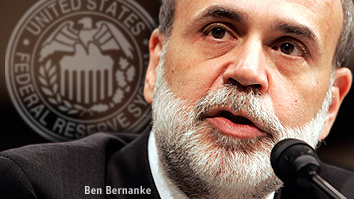America’s economy
美國(guó)經(jīng)濟(jì)
Wait and see
等待觀望
The Fed reckons the financial crisis has not yet seriously undermined the economic outlook
美聯(lián)儲(chǔ)認(rèn)為這場(chǎng)金融危機(jī)尚未嚴(yán)重?fù)p害美國(guó)經(jīng)濟(jì)前景

DEFYING market expectations for a cut, America’s Federal Reserve kept its short-term interest rate target steady at 2% on Tuesday September 16th. The statement accompanying the decision was, at first glance, hard nosed. Ben Bernanke and his fellow central bankers reckon that “The downside risks to growth and the upside risks to inflation are both of significant concern”, implying an equal propensity to raise rates as to lower them.
與市場(chǎng)減息的預(yù)期相悖,美聯(lián)儲(chǔ)在周二(9月16日)繼續(xù)保持其短期利率目標(biāo)2%不變。乍看起來(lái),這樣的聲明和決定是非常死板頑固的。本伯南克和他中央銀行的同僚們認(rèn)為:”經(jīng)濟(jì)增長(zhǎng)的下行風(fēng)險(xiǎn)和通脹的上行風(fēng)險(xiǎn)都需要重點(diǎn)關(guān)注”,這也暗示了美聯(lián)儲(chǔ)對(duì)于加息和減息具有同等的傾向。
But a closer read suggests the risks have tilted in the direction of weaker growth and away from higher inflation, though not by enough to put a rate cut on the table yet. “Strains in financial markets have increased significantly and labour markets have weakened further”, it said. “Tight credit conditions, the ongoing housing contraction, and some slowing in export growth are likely to weigh on economic growth over the next few quarters.” These all reflect more concern than the statement that followed its meeting on August 5th. Gone was last month’s reference to elevated inflation expectations.
但是更進(jìn)一步地解讀顯示經(jīng)濟(jì)下滑的風(fēng)險(xiǎn)在增加而通脹的風(fēng)險(xiǎn)卻在減小,雖然這還不足以是美聯(lián)儲(chǔ)公開(kāi)地降息。”金融市場(chǎng)的形勢(shì)已經(jīng)異常嚴(yán)峻,而勞動(dòng)力市場(chǎng)還會(huì)更糟,”美聯(lián)儲(chǔ)認(rèn)為,”信貸緊縮、住房市場(chǎng)的日益委縮和出口增長(zhǎng)的放緩在未來(lái)幾個(gè)季度內(nèi)可能會(huì)對(duì)經(jīng)濟(jì)增長(zhǎng)構(gòu)成壓力。”所有這些事情都比那個(gè)依循8月5日會(huì)議而做的陳述更加值得關(guān)注。上月提到的升高通脹的預(yù)期已經(jīng)不存在了。
Still, given the convulsions that have just swept the markets-the bankruptcy of Lehman Brothers’ holding company, the bail-out of AIG and Monday’s 4% plunge in stock prices-why not cut rates?
而且,考慮到市場(chǎng)剛剛遭受掃蕩–雷曼兄弟倒閉,美國(guó)國(guó)際集團(tuán)被接管和周一股票市場(chǎng)4%的大幅下挫–為何還不減息呢?
To be sure, doing so might have been hard for the Fed’s hawks to swallow. Only a month ago officials thought their next move would be to raise rates, not lower them. On the other hand, inflation risks have clearly receded. The price of oil, which topped $140 a barrel in July, fell below $93 on Tuesday.
但是可以肯定的是,降息很難被美聯(lián)儲(chǔ)鷹派所接受。僅在一個(gè)月前美聯(lián)儲(chǔ)的官員還認(rèn)為下一步要做的是加息而不是減息。另一方面,通脹上行的風(fēng)險(xiǎn)已經(jīng)明顯地降低。在七月份最高達(dá)140元每桶的油價(jià)已經(jīng)在周二降到每桶93美元以下。
Consumer prices actually declined by 0.1% in August compared with the month before, the Labour Department said on Tuesday. That brought the annual inflation rate down to 5.4% from 5.6%. It will almost certainly fall sharply in the coming year. Core prices, which exclude food and energy, rose by 0.2%, keeping the core inflation rate at 2.5%. The Fed had thought core inflation might creep higher this year as prior energy price increases were passed through to other products, so the tame core reading might have been a pleasant surprise. Finally, with the unemployment rate now up to 6.1%, disinflationary slack is rapidly accumulating in the economy.
美國(guó)勞工部周二表示,八月份消費(fèi)者價(jià)格指數(shù)比前一月下降了0.1%。這使得年度通脹率從5.6%降到了5.4%。而且這個(gè)數(shù)字明年還會(huì)大幅下降。核心價(jià)格,不包括食品和能源,升了0.2%。這使得核心通脹率保持在2.5%。美聯(lián)儲(chǔ)原來(lái)認(rèn)為由于油價(jià)的飆升會(huì)傳導(dǎo)引起其它產(chǎn)品價(jià)格的上升從而使得核心通脹率會(huì)上升,因次現(xiàn)在溫和的核心通脹指數(shù)將會(huì)是個(gè)意外的驚喜。最終,隨著現(xiàn)在失業(yè)率上升至6.1%,抑制通貨膨脹率政策的松懈必將迅速積累并在整體經(jīng)濟(jì)狀況上體現(xiàn)出來(lái)。
The likeliest explanation for the Fed’s decision to stand pat is that it is too soon to know whether the recent developments have affected growth. The Fed may reckon that a 2% funds rate should be sufficient to get the economy through its current slump. There are also other tools to contain the risk: the Fed expanded the size of one of its lending programmes and broadened the type of collateral it accepts in another, and the Treasury has the ability to purchase mortgage-backed securities.
美聯(lián)儲(chǔ)堅(jiān)持利率不變的決定最有可能的解釋是現(xiàn)在還太早,無(wú)法判斷最近的新情況是否對(duì)經(jīng)濟(jì)增長(zhǎng)有影響。美聯(lián)儲(chǔ)認(rèn)為2%的利率足以使得現(xiàn)在的經(jīng)濟(jì)走出低估。還有其它的工具來(lái)控制風(fēng)險(xiǎn):美聯(lián)儲(chǔ)擴(kuò)大了其借貸方案,增加了可作擔(dān)保物品的種類,而且財(cái)政部有能力購(gòu)買有抵押證券。
The risks that surrounded a potential collapse of AIG, of course, pose another problem altogether since its life-threatening crisis crystallised quite suddenly, and it is larger and more complex than Lehman. And unlike Lehman, the Fed does not know the firm well (it’s regulated by the state of New York). Christine Cumming, first vice-president of the Federal Reserve Bank of New York, voted in the place of the president, Timothy Geithner, who stayed in New York to oversee the rescue of the big insurer.
美國(guó)國(guó)際集團(tuán)可能破產(chǎn)引發(fā)的風(fēng)險(xiǎn),由于其危機(jī)形成的異常迅速而引發(fā)一系列的問(wèn)題,而且它比雷曼大得多也復(fù)雜得多。與雷曼不同的是,美聯(lián)儲(chǔ)對(duì)美國(guó)國(guó)際集團(tuán)了解的不夠(它由紐約州監(jiān)管)。紐約聯(lián)邦儲(chǔ)備銀行第一副主席Christine Cumming被投票表決代替主席Timothy Geithner。Timothy Geithner在紐約監(jiān)督營(yíng)救這個(gè)大型保險(xiǎn)商。
A rate cut now might not even have been felt: the collapse of Lehman has triggered a mad scramble for cash by banks, driving the interbank-lending rate as high as 6% in recent days. The Fed has responded with massive injections of cash into the money market to get the rate down. In that environment, a rate cut would have signalling value but would not rapidly translate into actual borrowing costs.
現(xiàn)在減息可能會(huì)沒(méi)有效果:雷曼的破產(chǎn)引發(fā)了銀行間對(duì)現(xiàn)金的瘋狂搶奪,使得銀行同業(yè)拆借利率在最近今天內(nèi)升至6%。美聯(lián)儲(chǔ)的響應(yīng)是給金融市場(chǎng)注入大量的現(xiàn)金使得拆借利率下降。在這樣的環(huán)境下,減息只有作為信號(hào)的價(jià)值,而不會(huì)迅速轉(zhuǎn)化為實(shí)際的借錢成本。











